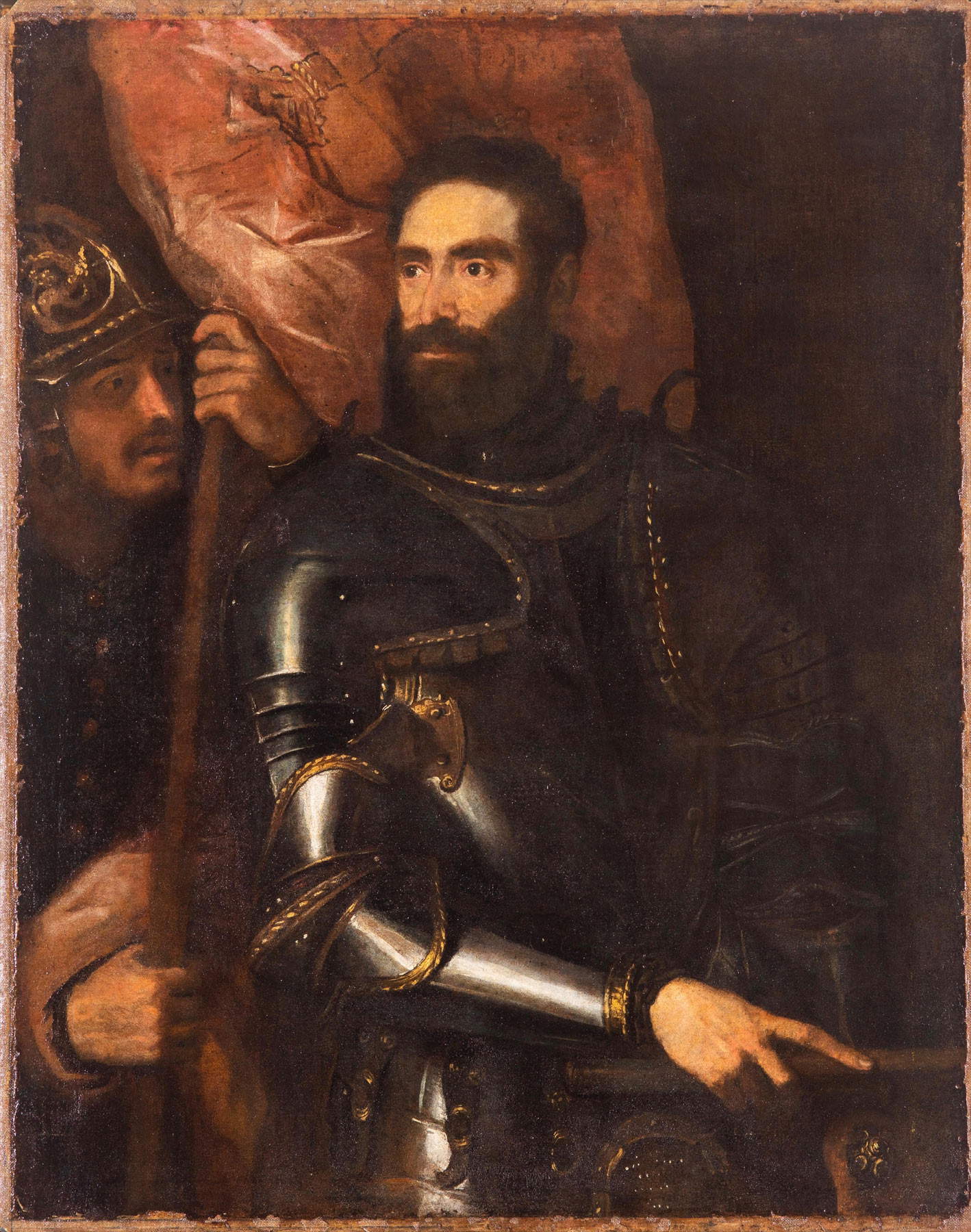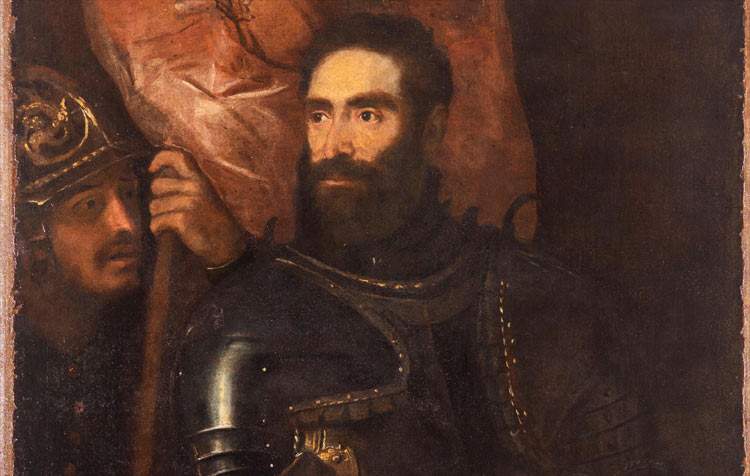The restoration of the Portrait of Pier Luigi Farnese in Armor, a 1546 work by Tiziano Vecellio, was presented this morning at theCentral Institute for Restoration in Rome. The painting is part of the Farnese collection at the Museo e Real Bosco di Capodimonte in Naples, which came to the city with the accession to the throne of Charles of Bourbon (1734), thanks to a gift from the collection of his mother Elisabetta Farnese. The proud and haughty figure of Pier Luigi Farnese (1503-1547), eldest son of Pope Paul III, imposes itself on view with authority and strength, enclosed in his dazzling condottiere armor with the flag that recalls the post of Gonfaloniere and general of the papal army, assigned to him by his father Pope Paul III Farnese in 1545, along with the highly prestigious post of duke of Parma and Piacenza. Titian, a portraitist for the Farnese family, captures Pier Luigi in three-quarter profile, capturing the effects of light shimmering on his armor with inimitable mastery.
The work will be on display, starting March 18, 2022 at the Complesso Monumentale della Pilotta in Parma as part of the exhibition I Farnese. Architecture, Art, Power, sponsored by the Ministry of Culture and included in the projects of Parma Italian Capital of Culture 2020+21, an exhibition to which the Museo e Real Bosco di Capodimonte contributes significantly with the loan of a significant nucleus of paintings, armor and precious objects from the Farnese Wunderkammer. The restoration of the painting is part of the project Rivelazioni. Finance for Fine Arts by Borsa Italiana, launched by the Museo e Real Bosco di Capodimonte in 2018. Thanks to the art bonus mechanism, three Campania-based companies (Tecno, Pasell and Graded), all included in Borsa Italiana’s Elite program for companies with high growth potential, were able to finance the campaign of diagnostic investigations and restoration, giving rise to an integrated model of patronage, promoted and supported by the Advisory Board of the Capodimonte Museum and Real Bosco, chaired by Giovanni Lombardi, which led to the restoration of other important paintings.

Tiziano Vecellio’s Portrait of Pier Luigi Farnese in Arm or is part of the Farnese collection of the Museo e Real Bosco di Capodimonte, which came to Naples with the accession to the throne of Charles of Bourbon (1734) and the gift of the collection of his mother, Elisabetta Farnese. The nucleus of paintings made for the Farnese family by Titian, a guest of the court in Rome in 1545, includes some of the most celebrated portraits in all of 16th-century European painting, most of which are preserved at Capodimonte. The Farnese dynasty, originating from the small Latium nobility of Tuscia, was not always on the side of the Church, to the extent that Pier Luigi Farnese, in the service of Charles V in 1527, participated in the sack of Rome, taking advantage of the occasion to safeguard the Farnese Palace, while his brother Ranuccio usefully protected Clement VII, who had taken refuge in Castel Sant’Angelo. This opportunistic ambiguity accompanied the incessant changes of alliance in the politics of the time. And it can be perceived in this very work where the broad banner, marked by the emblem of Gonfaloniere della Chiesa (the chamber pavilion with crossed keys) highlights the important office received in 1537 by Pier Luigi’s father, Pope Paul III Farnese.
With its charged hue and warm reflections, it helps to highlight the pale, hollowed-out face of the ailing duke, on which the emotional violence of the gaze stands out, with its vivid eyes and thin, tense mouth, a mirror of the bloody, resolute temperament and transgressive, desecrating personality, almost presaging the violent death that would befall him as a result of a conspiracy hatched against him in 1547, a year after the portrait was painted. Titian probably painted this canvas in Venice around 1546, after his return from Rome at the invitation of Pope Paul III. A probable contact between Pier Luigi and Titian must have taken place in Emilia in 1543, as the duke was not present during Titian’s stay in Rome. In this painting, Titian depicts Pier Luigi in a three-quarter profile, almost suggesting a shift from contemplation to action, amplified by the gesture of his right hand grasping the staff, the symbol of his military command, while the other grips in the shadows the handle of a dagger ready to be grasped. The armor worn by Pier Luigi Farnese in the portrait executed by Titian is not representational, but assimilated to the typical armor of military use of the time. The decoration is very simple, resulting in a total blackening of the surfaces, with low, gilded borders highlighting the edges of the metal blades. A small etched decoration seems to emphasize the neckline in the French manner. Strong similarities can be detected with the very similar armor worn by Alfonso d’Avalos in theAllocution painted by Titian himself and now in the Prado. The helmet of the banner-bearing soldier is adorned with a scroll motif that we find on the three-crested helmets of the Farnese Guard in embossed and painted iron, now preserved in the Armory of the Museo e Real Bosco of Capodimonte.
The Portrait of Pier Luigi Farnese in Armor presented conditions of legibility compromised by a considerable presence of small, diffuse gaps and abrasions and by the alteration of the protective layers, glues and paints, applied in the previous restoration. The work had already been restored earlier, in 1957, again at the Central Institute for Restoration, at the time directed by Cesare Brandi, as part of the overall conservation overhaul of the Neapolitan museum’s masterpieces when Bruno Molajoli arranged for its transfer to the Royal Palace of Capodimonte. The painting, which needed a consolidation of the pictorial layers, was lined with paste glue at the time and then mounted on an innovative tensioning system, consisting of a wooden frame with spring expansion, which was being experimented with and proved to be very effective over time. The old repainting was removed, then very limited operations of aesthetic presentation were carried out, in accordance with the extremely rigorous approach that was pursued at the Institute at the time, leaving some of the gaps in the paint film visible. The Painting on Canvas Laboratory of the Central Institute for Restoration since 2005 has been carrying out a project to review the restorations conducted by the Institute during the 1950s, in order to assess their stability and effectiveness over time. It therefore appeared to be the most appropriate venue to tackle this new intervention, which responded to the need to verify the effectiveness of the structural measures taken in 1957 and critically review the aesthetic presentation, also in light of the state of conservation of the restoration materials. The main problem of the work was related to the usability of the image, marred by the presence of the numerous losses of the pictorial film that had brought the supporting canvas into view.
The current intervention was preceded by an extensive diagnostic campaign, carried out by Emmebi Diagnostica Artistica, Arsmensurae and the Laboratoire d’Archéologie Moléculaire et Structurale (LAMS) in Paris. Research with advanced methodologies that allowed the acquisition of new information on the execution technique of the painting, useful to better address the delicate restoration. Reflected-light and trans-irradiance infrared reflectography, investigations that allow us to see beneath the surface pictorial layers, have returned traces of the underlying drawing and some pentimenti. The MA-XRF investigation, which returns in gradations of gray the presence of each chemical element, was performed on the entire painted surface and revealed important information about Titian’s execution technique. The artist sets the composition from a rather subtle outline drawing, which the infrared detects, for example, along the outlines of the soldier’s left hand and Pier Luigi Farnese’s eyes and ear. The precision of the physiognomic features is accompanied by the freer definition of the sketch in terms of the leader’s pose and setting. The right arm presents a more raised first drafting with the hand said to be resting on a plane, rather than clutching the staff of command. This novel reading is suggested precisely by the mapping of the painted surface through MA -XRF investigation, which allowed the distribution of chemical elements to be traced. This investigation makes it possible to reconstruct both the changes in progress and the original chromatic components, made difficult to interpret by the precarious state of preservation and the alterations undergone by some pigments. This is the case of the now-blackened green of which the soldier’s bodice is made, detected in detail by the copper distribution image, which also highlights the copper-based pigment (azurite) used for the blue intonation of the armor. The presence of different elements, revealed by Macro XRF, and hyperspectral survey, makes clear the complexity of the pictorial layering, which employs white lead, calcium white, earths, azurite, and bone black in the armor.
In the ICR Biological Investigations Laboratory on the original support, microscopic analyses were also conducted in order to recognize the constituent textile fibers, which were identified as flax fibers (Linum usitatissimum L.). The ICR Physics Laboratory, on the other hand, studied and evaluated the level of tension applied to the painting. The system, of the ’elastic’ type, is arranged to limit the frictional force and give adequate freedom of movement to the support, allowing the painting to flow and change its dimensions as a result of changes in environmental parameters. During the restoration phases, a helical metal spring was taken and subjected to a tensile test to calculate the value of linear tension applied to the painting, which was found to be uneven. Therefore, action was taken to make minor modifications to make it optimal, without making any changes to the configuration of the now-historicized structure and mechanisms.
As for theintervention on the pictorial surface, having verified the efficiency of the adhesion of the paste glue lining, the structural conservative conditions were found to be substantially good. From the point of view of the image, however, the painting was very damaged. The intervention was directed at the restoration of cohesion defects in the paint film, the removal of the varnishes from the previous restoration, now oxidized, andthe thinning of the glues used for the 1957 lining. The aesthetic presentation of the work was then addressed, rethinking the reintegration of the gaps and abrasions with the aim of recovering a more readable figuration for a better enjoyment of the image, performing “undertone” glazing in the gaps where the canvas surfaced and in the abraded areas.
 |
| Naples, Titian's portrait of Pier Luigi Farnese in armor restored |
Warning: the translation into English of the original Italian article was created using automatic tools. We undertake to review all articles, but we do not guarantee the total absence of inaccuracies in the translation due to the program. You can find the original by clicking on the ITA button. If you find any mistake,please contact us.